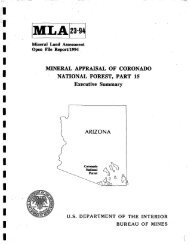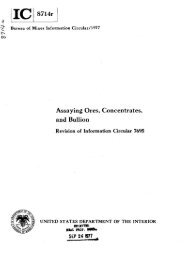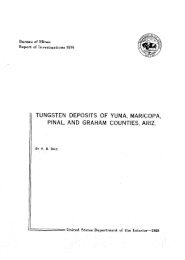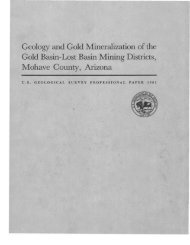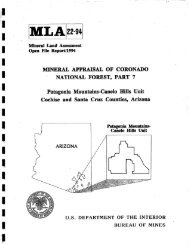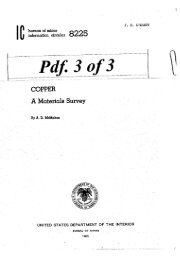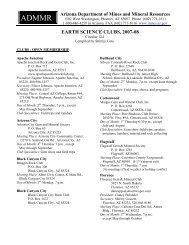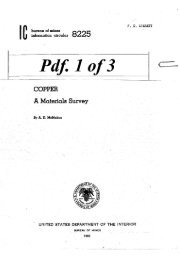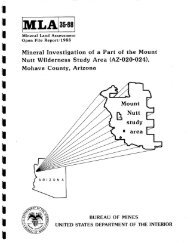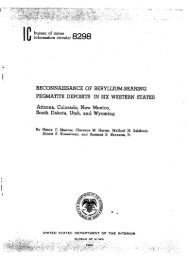here - State of Arizona Department of Mines and Mineral Resources
here - State of Arizona Department of Mines and Mineral Resources
here - State of Arizona Department of Mines and Mineral Resources
You also want an ePaper? Increase the reach of your titles
YUMPU automatically turns print PDFs into web optimized ePapers that Google loves.
COVE DISTRICT<br />
The Cove district is 45 miles northeast <strong>of</strong> Bakersfield<br />
near Kernville, in T. 25 S., R. 33 E.<br />
In the late 1850's a few placers were worked in<br />
the Cove district by the more persistent <strong>of</strong> the<br />
prospectors drawn to the area by the original discoveries<br />
in Kern County, along the Kern River, in<br />
1851. Gold-bearing quartz veins were found in 1860.<br />
The towns <strong>of</strong> Quartzburg <strong>and</strong> Kernville, which were<br />
founded in the boom that followed, experienced a<br />
period <strong>of</strong> orderly growth <strong>and</strong> prosperity. The Big<br />
Blue mine <strong>of</strong> Kern <strong>Mines</strong>, Inc., was discovered early<br />
in the history <strong>of</strong> the district. The mine became the<br />
major producer <strong>and</strong> was credited with $1,746,910<br />
in gold to 1933 (Tucker <strong>and</strong> others, 1949, p. 211) ;<br />
most <strong>of</strong> this production was in the first few years<br />
<strong>of</strong> the mine's activity. In 1883 most <strong>of</strong> the workings<br />
were destroyed by fire, <strong>and</strong> the mine was inactive<br />
until 1907 when the first <strong>of</strong> several unsuccessful<br />
attempts was made to rehabilitate the property.<br />
Total gold production <strong>of</strong> the district through 1959<br />
was about 262,800 ounces; none had been reported<br />
since 1942.<br />
The country rock consists <strong>of</strong> metasedimentsphyllites,<br />
quartzites, <strong>and</strong> limestone <strong>of</strong> the Kernville<br />
Series <strong>of</strong> Carboniferous (1) age, <strong>and</strong> the Isabella<br />
Granodiorite <strong>and</strong> acidic dikes <strong>of</strong> Jurassic(?) age.<br />
The granodiorite is probably related to the main<br />
Sierra Nevada batholith (Prout, 1940, p. 385-389;<br />
Miller <strong>and</strong> Webb, 1940, p. 378).<br />
The metamorphic rocks are intensely deformed<br />
<strong>and</strong> crumpled by the intrusive rock. Along the east<br />
edge <strong>of</strong> the Cove district is the north-trending Kern<br />
Canyon fault, the major structure in the area.<br />
Ore deposits consist <strong>of</strong> veins which seem to be<br />
related to the closing stages <strong>of</strong> igneous activity. The<br />
veins occur in shear zones, parallel to the Kern<br />
Canyon fault, <strong>and</strong> are associated with acidic dikes<br />
that cut the granodiorite <strong>and</strong> metasediments (Prout,<br />
1940, p. 386, 391-392). The veins are dominantly<br />
quartz with small amounts <strong>of</strong> calcite. The ore minerals<br />
are gold, which occurs in the free state, arsenopyrite,<br />
galena, <strong>and</strong> sphalerite (Prout, 1940,<br />
p. 411-412).<br />
GREEN MOUNTAIN DISTRICT<br />
The Green Mountain district includes the area<br />
between Piute, on the west slope <strong>of</strong> the Piute Mountains,<br />
<strong>and</strong> the edge <strong>of</strong> Kelsey Valley, on the east side<br />
<strong>of</strong> the Piute Mountains.<br />
Gold production <strong>of</strong> this district through 1959 was<br />
about 33,100 ounces. The Bright Star mine was the<br />
major producer, with an estimated $600,000 total<br />
output (Tucker <strong>and</strong> Sampson, 1933, p. 280).<br />
CALIFORNIA 65<br />
Bedrock in the area consists <strong>of</strong> metasedimentary<br />
rocks <strong>of</strong> the Kernville Series <strong>of</strong> Carboniferous (1)<br />
age <strong>and</strong> Isabella Granodiorite <strong>of</strong> Jurassic (1) age<br />
(Miller <strong>and</strong> Webb, 1940, p. 349-358). The metasedimentary<br />
rocks occur in northwest-trending b<strong>and</strong>s<br />
<strong>and</strong> include marble, phyllite, mica schist, <strong>and</strong><br />
quartzite. The gold deposits are in small, but rich,<br />
shoots in narrow quartz veins.<br />
KEYES DISTRIOV<br />
The Keyes district, 35 miles north <strong>of</strong> Calientp. in<br />
T. 26 S., Rs. 32 <strong>and</strong> 33 E., produced about 3S,600<br />
ounces <strong>of</strong> gold through 1959, all from lodes.<br />
Detailed accounts <strong>of</strong> the history <strong>and</strong> geolog:'T <strong>of</strong><br />
this district were not found; however, Tucker <strong>and</strong><br />
Sampson (1933, p. 283) reported that the deposits<br />
in the district are in narrow high-grade vein" in<br />
granite.<br />
RAND DISTRICT<br />
The R<strong>and</strong> district is on the San Bernardino-Yern<br />
County line. R<strong>and</strong>sburg, 45 miles northeast <strong>of</strong><br />
Mojave, is in the center <strong>of</strong> the district. Althc'lgh<br />
more than half the area is in San Bernardino<br />
County, nearly all the gold mined in the district<br />
has come from the western part, in Kern County.<br />
This is the most important district in Kern County,<br />
<strong>and</strong> it contains the largest gold mine in the county,<br />
the Yellow Aster. Gold has been the chief r'lmmodity<br />
mined; silver has been a byproduct.<br />
Placer gold was discovered in the winter <strong>of</strong> U'q3<br />
94 at Goler Wash, 9 miles northwest <strong>of</strong> R<strong>and</strong>sb'lrg,<br />
<strong>and</strong> by 1895 the lode deposits <strong>of</strong> the Yellow Aster<br />
mine were developed (Hess, 1910, p. 31-32). Of the<br />
estimated $9 to $10 million worth <strong>of</strong> ore mined<br />
before 1910, the Yellow Aster produced $6 miJIion<br />
(Hess, 1910, p. 32).<br />
Tucker <strong>and</strong> Sampson (1933, p. 285-286) ("ave<br />
estimates <strong>of</strong> the production <strong>and</strong> a brief account <strong>of</strong><br />
the geology. Gold production through 1959 was<br />
836,300 ounces, all but about 1,700 ounces was<br />
from lode mines.<br />
The country rock in the gold-producing par <strong>of</strong><br />
the district consists <strong>of</strong> the R<strong>and</strong> Schist <strong>and</strong> the<br />
Atolia Quartz Monzonite which intruded the scl'ist.<br />
Numerous rhyolite pipes, dikes, <strong>and</strong> sills <strong>of</strong> late<br />
Miocene age are found locally. Gold ores occur in<br />
fissure veins <strong>and</strong> as impregnations <strong>and</strong> stockworks<br />
in both the monzonite <strong>and</strong> R<strong>and</strong> schist. The<br />
strongest veins have been found to be in two systems-one<br />
strikes N. 80° E. <strong>and</strong> the other, northwest.<br />
The principal vein minerals are quartz, arsenopyrite,<br />
pyrite, galena, gold, scheelite, iron



